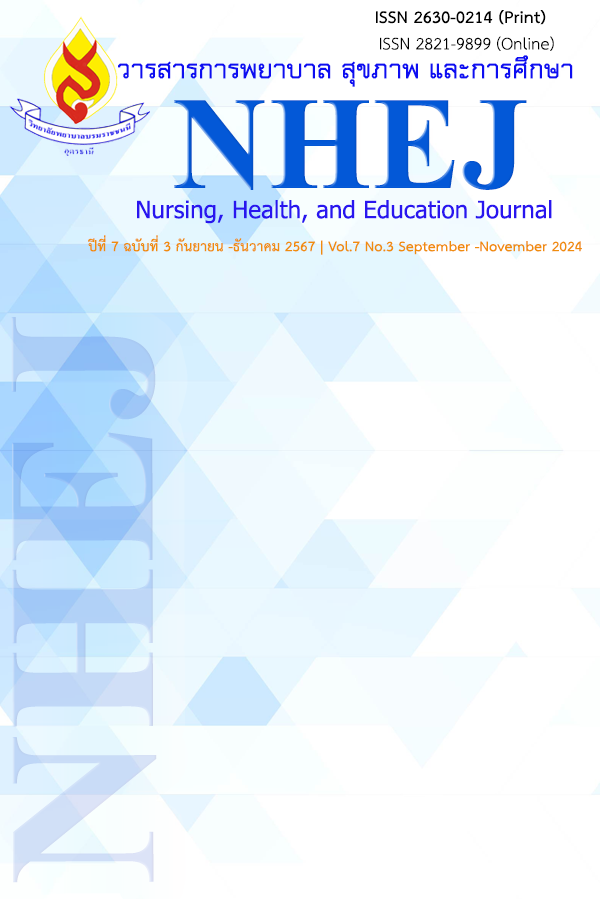Effectiveness of Using the Nursing Practice Guidelines to Care for Patients with Hemorrhagic Stroke with Non-Operation Admitted to the Neurosurgery Intensive Care Unit
Keywords:
Nursing practice guidelines, Hemorrhagic stroke, Systolic blood pressure, Increased intracranial pressureAbstract
The aim of this research was to develop and study the effectiveness of nursing practice guidelines for the care of hemorrhagic stroke patients receiving non-surgical treatment and admitted to the neurosurgical intensive care unit of Nopparat Rajathanee Hospital. The participants consisted of 90, divided into a control group of 45 and an experimental group of 45. The research instrument was the nursing practice guidelines for the care of patients with hemorrhagic stroke who received non-surgical treatment. The instruments used to collect data for patients consisted of 4 sets: a personal data record form, a screening form for the severity of hemorrhagic stroke, a modified Rankin scale, and an increased intracranial pressure assessment form. Data were analyzed using descriptive statistics: chi-squared test, Fisher's exact test, independent t-test, and repeated measure ANOVA. The results of the research found that after using the nursing practice guidelines, systolic blood pressure could be reduced significantly after 1 hour and 24 hours of admission. The incidence of intracranial hypertension and mortality were also significantly reduced. The results of the study showed that the developed nursing practice guidelines were effective in controlling blood pressure and reducing major complications in patients with cerebral infarction. They can be applied as care for this patient group in the intensive care unit to further improve nursing quality and clinical outcomes.
References
Unnithan AKA, Das JM, Mehta P. Hemorrhagic Stroke [Internet]. Treasure Island (FL): StatPearls
Publishing; 2023 [cited 2024 Nov 25]. Available from: https://www.ncbi.nlm.nih.gov/books/NBK559173/
Nisar T, Alchaki A, Hillen M. Validation of ICH score in a large urban population. Clin Neurol
Neurosurg. 2018;174:36-39.
Rangsawat S. Factors affecting 30-day mortality rate in patients with primary intracerebral
hemorrhage at Mukdahan Hospital. Nakhon Phanom Hosp J. 2021;8(2):28-43. In Thai.
Magid-Bernstein J, Girard R, Polster S, Srinath A, Romanos S, Awad IA, et al. Cerebral
Hemorrhage: Pathophysiology, Treatment, and Future Directions. Circ Res. 2022;130(8):1204-29.
An SJ, Kim TJ, Yoon BW. Epidemiology, Risk Factors, and Clinical Features of Intracerebral
Hemorrhage: An Update. J Stroke. 2017;19(1):3-10.
Tiamkao S. Stroke situation in Thailand. J Thai Neurol. 2021;37(4):54-60. In Thai.
Hemphill JC 3rd, Greenberg SM, Anderson CS, Becker K, Bendok BR, Cushman M, et al.
Guidelines for the Management of Spontaneous Intracerebral Hemorrhage: A Guideline for
Healthcare Professionals From the American Heart Association/American Stroke Association.
Stroke. 2015;46(7):2032-60.
Frontera JA, Lewin JJ 3rd, Rabinstein AA, Aisiku IP, Alexandrov AW, Cook AM, et al. Guideline
for Reversal of Antithrombotics in Intracranial Hemorrhage: A Statement for Healthcare
Professionals from the Neurocritical Care Society and Society of Critical Care Medicine.
Neurocrit Care. 2016;24(1):6-46.
Rojana S. Development of nursing care model for hemorrhagic stroke patients with
hypertension. Thai J Cardiovasc Thorac Nurs. 2020;31(2):206-21. In Thai.
Siripraphaphon S, Panprasert S, Ditprae S. Development of care system for hemorrhagic
stroke patients with hypertension at Somdejphraphutthalertla Hospital. J Health Sci.
;31(2):s353-64. In Thai.
Saeng-in P, Thongmee P, Plueynongkae S, Petsanghan P, Hanlue K, Saenyamool S.
Development of nursing practice guidelines for hemorrhagic stroke patients in neurosurgical
intensive care unit, Roi Et Hospital. J Nurs Health Care. 2024;42(3):e272542. In Thai.
Soukup SM. The Center for Advanced Nursing Practice evidence-based practice model:
promoting the scholarship of practice. Nurs Clin North Am. 2000;35(2):301-9.
Cohen J. Statistical power analysis for the behavior sciences. 2nd ed. New York: Lawrence
Erlbaum Associates; 1988.
Hemphill JC, Bonovich DC, Besmertis L, Manley GT, Johnston SC. The ICH Score: A Simple,
Reliable Grading Scale for Intracerebral Hemorrhage. Stroke. 2001;32(4):891-7.
Rankin J. Cerebral vascular accidents in patients over the age of 60. II. Prognosis. Scott Med
J. 1957;2(5):200-15.
Joanna Briggs Institute. JBI EBP Database Guide [Internet]. 2024 [cited 2024 Nov 25]. Available
from: https://ospguides.ovid.com/OSPguides/jbidb.htm
Neurological Institute of Thailand. Clinical practice guideline for hemorrhagic stroke: Care
map for hemorrhagic stroke. Bangkok: Thana Press; 2019. In Thai.
Aldhaeefi M, Badreldin HA, Alsuwayyid F, Alqahtani T, Alshaya O, Al Yami MS, et al. Practical
Guide for Anticoagulant and Antiplatelet Reversal in Clinical Practice. Pharmacy (Basel).
;11(1):34.
Teo KC, Keins S, Abramson JR, Leung WCY, Leung IYH, Wong YK, et al. Blood Pressure
Control Targets and Risk of Cardiovascular and Cerebrovascular Events After Intracerebral
Hemorrhage. Stroke. 2023;54(1):78-86.
Kuramatsu JB, Gerner ST, Schellinger PD, Glahn J, Endres M, Sobesky J, et al. Anticoagulant
reversal, blood pressure levels, and anticoagulant resumption in patients with
anticoagulation-related intracerebral hemorrhage. JAMA. 2015;313(8):824-36.
Law ZK, Appleton JP, Bath PM, Sprigg N. Management of acute intracerebral haemorrhage –
an update. Clin Med (Lond). 2017;17(2):166-72.
Shoamanesh A, Lindsay MP, Castellucci LA, Cayley A, Crowther M, de Wit K, et al. Canadian
stroke best practice recommendations: Management of Spontaneous Intracerebral
Hemorrhage, 7th Edition Update 2020. Int J Stroke. 2021;16(3):321-41.
Manchi MR, Venkatachalam AM, Atem FD, Stone S, Mathews AA, Abraham AM, et al. Effect of
inpatient rehabilitation facility care on ninety day modified Rankin score in ischemic stroke
patients. J Stroke Cerebrovasc Dis. 2023;32(6):107109.
Singkwang K. Development of clinical practice guidelines for initial assessment of increased
intracranial pressure warning signs in post brain tumor surgery patients. Buddhachinaraj
Med J. 2020;37(2):136-48. In Thai.
Downloads
Published
How to Cite
Issue
Section
License
Copyright (c) 2024 Boromarajonani College of Nursing Udonthani

This work is licensed under a Creative Commons Attribution-NonCommercial-NoDerivatives 4.0 International License.



